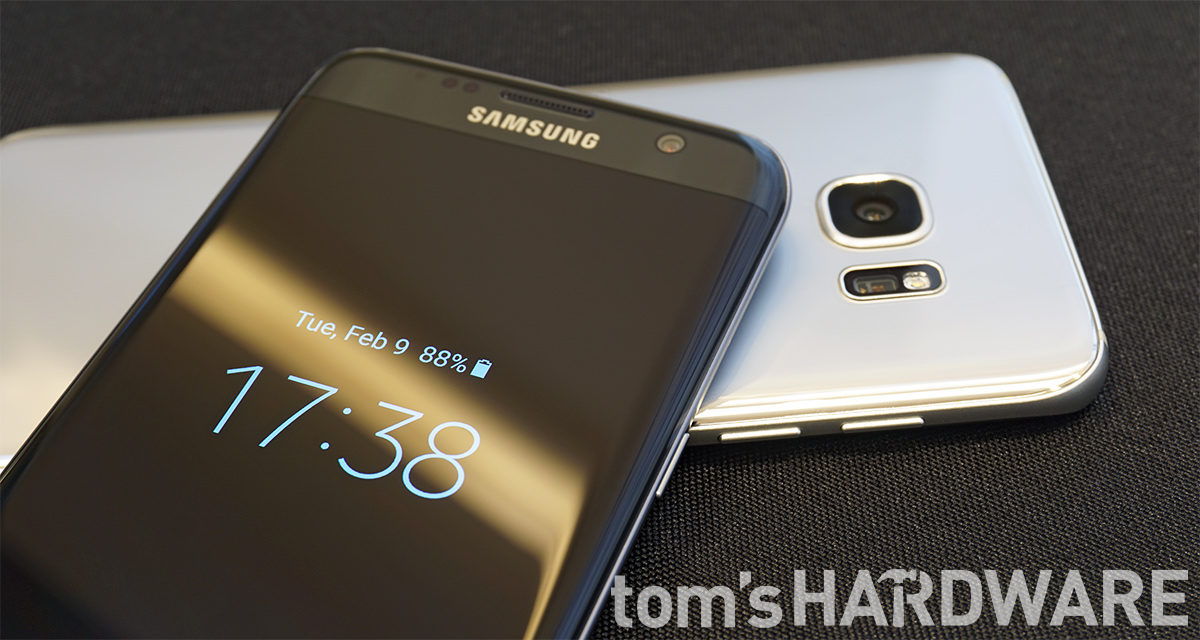Samsung Galaxy S7 And S7 Edge Preview
Introduction
The smartphone market has become increasingly competitive over the past several years. Samsung, like most of its peers, is facing a number of challenges, including more competition at the high-end, cheaper devices from Chinese OEMs, and market saturation. Last year, in an effort to jumpstart declining sales, Samsung radically redesigned its Galaxy line of flagship phones. Switching from an all-plastic to aluminum and glass construction meant more luxury and less utility, simultaneously attracting new buyers to the brand while alienating its most faithful fans.
The Galaxy S6 and its derivatives sacrificed several features for sexy curves. Protection against dust and water leaked away, and the battery became a prisoner inside the aluminum and glass cage, making easy battery swaps impossible. With the perimeter on lockdown, microSD cards found themselves locked out, denying users storage flexibility and expansion. This injustice only deepened when the more expensive Galaxy S6 edge+ and Note5—which limited internal storage to 64GB—launched later in the year.
After receiving volumes of vociferous feedback and gaining valuable experience with its new design language, Samsung is unleashing its seventh generation Galaxy devices. The Galaxy S7 and Galaxy S7 edge look to correct the shortcomings of the previous generation, even bringing back some of the previously discarded features such as support for microSD cards, which now share space with the Nano SIM card in a special dual-card tray located on the top edge. Samsung also restores environmental protection, giving the new Galaxies an IP68 rating that makes them dust tight and allows for immersion in water up to 5 feet for up to 30 minutes. Unlike the Galaxy S5, however, the Galaxy S7 devices do not require a plug to cover the USB port.
Battery life is one thing we can never get enough of, and while the Galaxy S6 family of devices compared favorably to their peers, the smaller Galaxy S6 and S6 edge struggled to last a whole day on a single charge during moderate to heavy use. In a move to address this issue, Samsung increases the battery size in the Galaxy S7 to 3,000mAh, up from 2,550mAh in the S6. The Galaxy S7 edge also gets a larger 3,600mAh battery, up from 3,000mAh in the S6 edge+. The fact that the battery remains sealed inside will likely remain a point of contention for some people, though.
Get Tom's Hardware's best news and in-depth reviews, straight to your inbox.
-
Nashten Glad to see that Samsung brought the MicroSD card slot back.Reply
I still won't buy a Samsung phone, but they look even better. I can't wait to see what the SD820 holds in store for us when more products hit the street with it.
I shouldn't talk about SD slots though considering I own a Nexus 6... :D -
xHDx What staggers me is how does a Phone manage to use that much RAM? Windows uses a max of 2/2.5Reply
-
Edwin Herdman The "(sensors with) smaller pixels are bad" line is a myth, and I'm disappointed to see it spread here. There are densely packed sensors, and there are physically large sensors - both are good things.Reply
Of course, if you had the exact same pixel count, larger pixels are naturally better, but this is not the question facing sensor makers. The "small pixels" line is harmful because it leads people to think that small pixels are naturally compared to large pixels - almost nobody does this, because it would mean viewing pixels off different size sensors at the same size. With a few exceptions, people compare the full images at the same size - where total sensor size is much more important.
DP Review's Richard Butler took a look at this question last year, with some extra math details on page 2 of the article "The effect of pixel size on noise." -
Calvin Huang Reply17541248 said:Micro-usb 2.0...
Come on!! Really?
I have a phone with USB-C (Nexus 6P), and while I do appreciate the ergonomics of the new plug (it both feels more secure while being less awkward to insert/unplug), the lack of compatibility is a huge drawback. I have to be sure to always carry my own cables with me, and there are no wireless charging dongles that use USB-C. So if you go to Starbucks and want to make use of their Qi charging pads, you're SOL. Granted, it'd be less of an issue if the device had Qi charging built-in, but in the case of the S7, it still doesn't make sense to release a phone that isn't compatible with their VR hardware. -
thezooloomaster ReplyMicro-usb 2.0...
Come on!! Really?
Who uses USB on phones for anything other than charging these days, anyway? -
none12345 Removing the MicroSD slot, and the waterproofiting from the s5 were 2 big mistakes. Glad to see they realized their stupidity and added them back in for the s7.Reply
I wouldn't even consider a phone that doesn't have a microsd slot.(or whatever replaces it in the future). The non-removable battery sucks, but its far easier to live with when the waterproofiting and microsd slot are back in. -
MasterMace USB 2.0 and a locked down battery are big signals for me to stay away from Samsung, still. That, and my experience with the GS4Reply -
giovanni86 Still concealing the battery. There almost back to normal. if there note 6 doesn't have battery removal its another year im skipping my Note 4 is plenty.Reply
